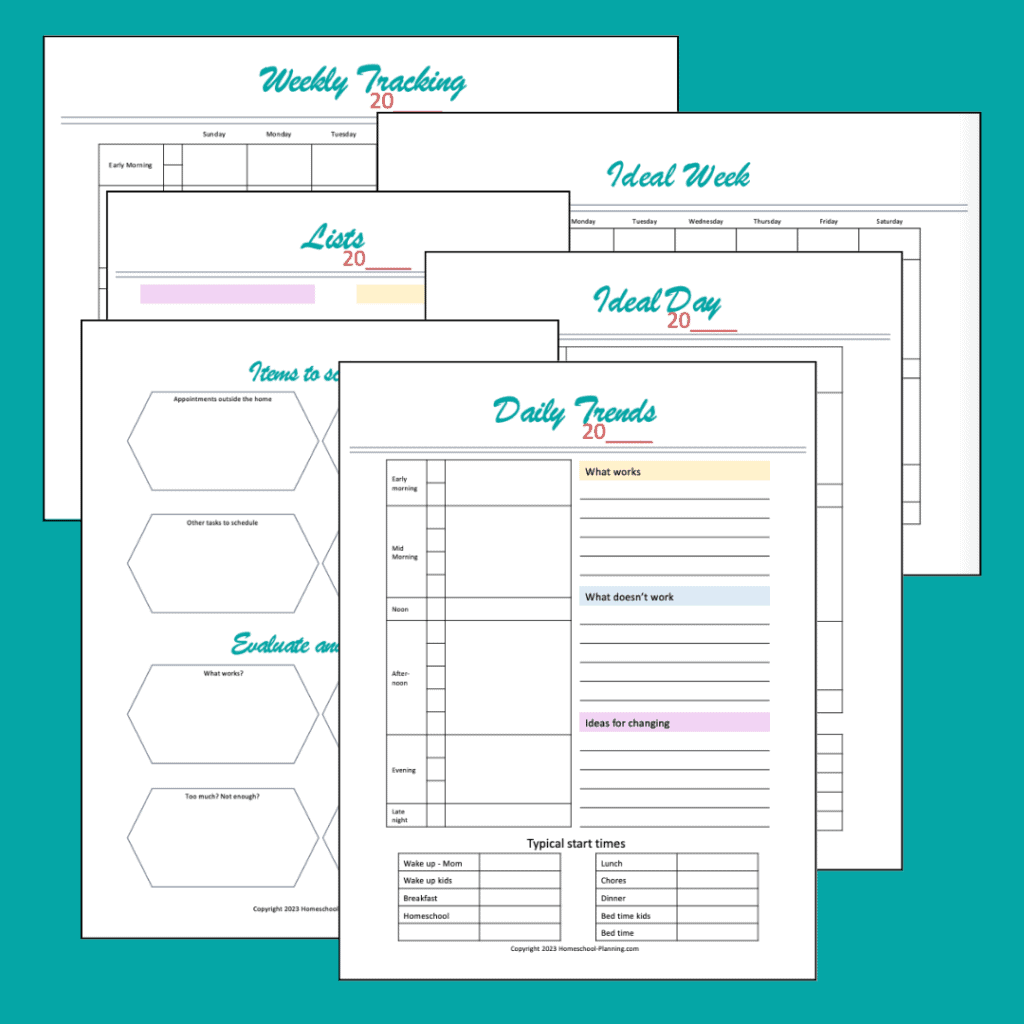Do you need some structure in your homeschool? Laying out a weekly homeschool schedule is a good first step. But how do you do that and what does a weekly schedule look like?
Keep reading for my easy process to set up a weekly homeschool schedule and tips to get you started!

What is a weekly homeschool schedule?
A weekly homeschool schedule is a framework to structure your homeschool week. This is not about what you do each day, but rather a big-picture overview of your week. Setting up a weekly schedule will be a starting point for building a more detailed daily schedule.
Creating your weekly homeschool schedule is a great step toward getting your homeschool days running smoothly. It helps you to view the flow of your week as a whole and make the necessary time for what is important: homeschooling your children.

How to plan your weekly homeschool schedule
Coming up with your own weekly homeschool schedule can be a big task. But I have broken it down into 10 easy steps so you don’t miss anything!
Be sure to download the free weekly homeschool schedule template to use as you go through each step. These worksheets will help you as you come up with your own schedule for your homeschool week.
Keep reading for my 10 steps and get started today.
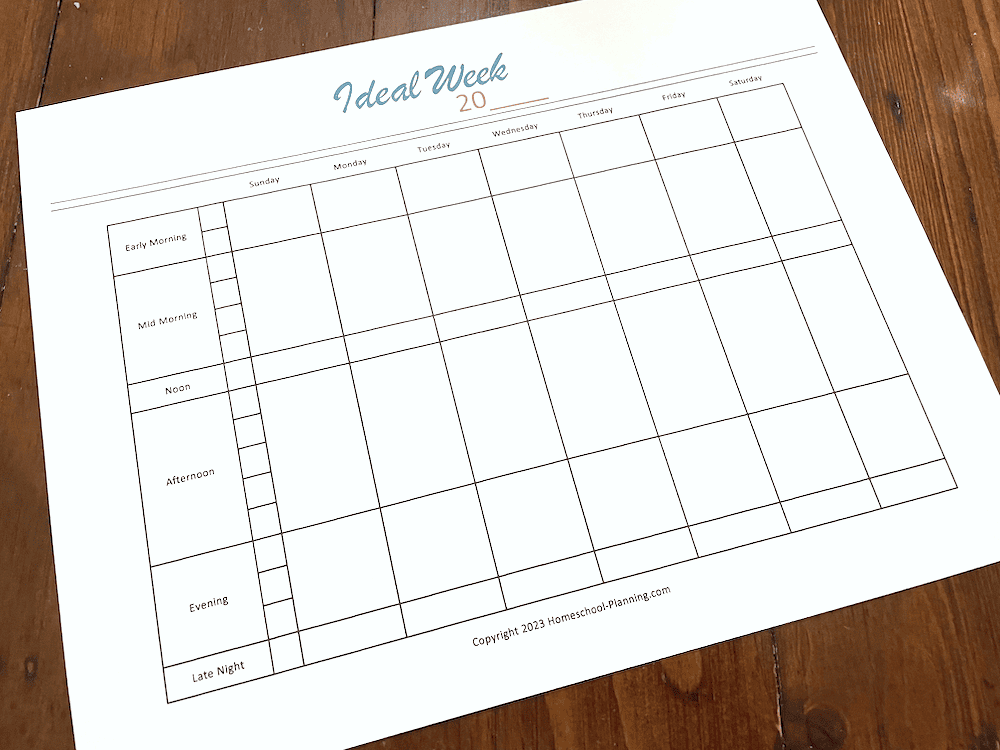
1. Create a weekly visual
It is helpful when planning your weekly homeschool schedule to use a visual layout. This is just a way to view your whole week at once in whatever way you find helpful. You may want to use a daily list, a vertical weekly layout, or a horizontal layout.
My free printable weekly schedule template gives you a horizontal layout to view all you need to plan on one page. To download your free printable, click here.
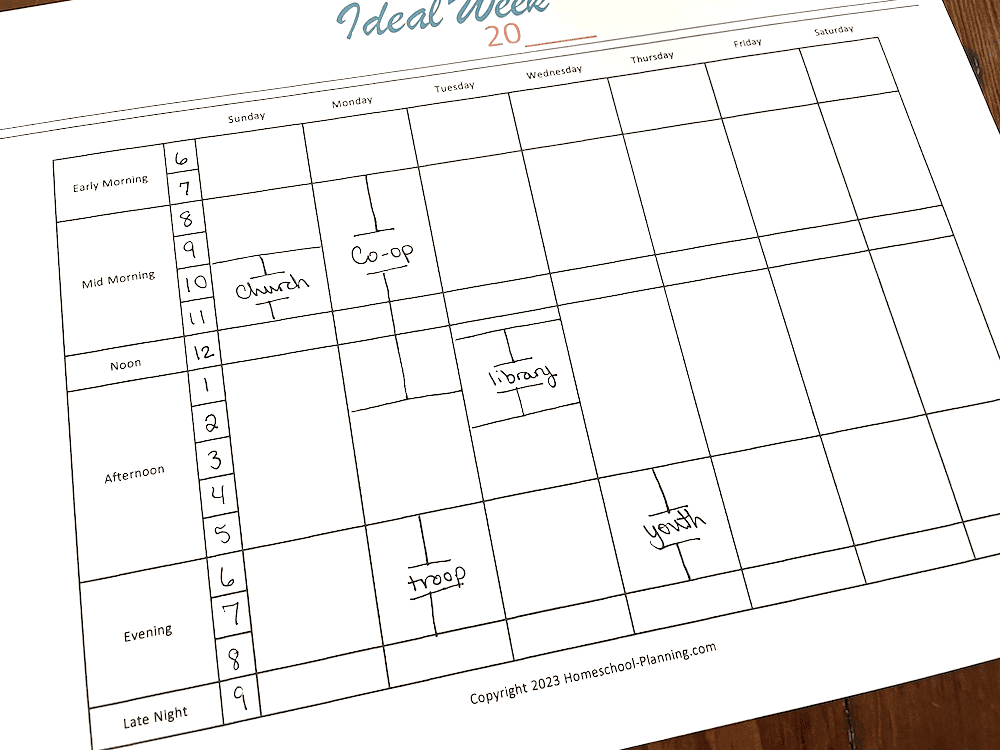
2. Add outside appointments
Starting with your blank weekly schedule template, add any recurring weekly appointments that have set times. These are usually things that are reliant on the schedule of others outside your home. These may include things like:
- Work
- Therapy
- Church
- Online classes
- Co-op or tutorial classes
- Extracurricular activities
- Private lessons
- Sports
- Any other recurring appointments with set times
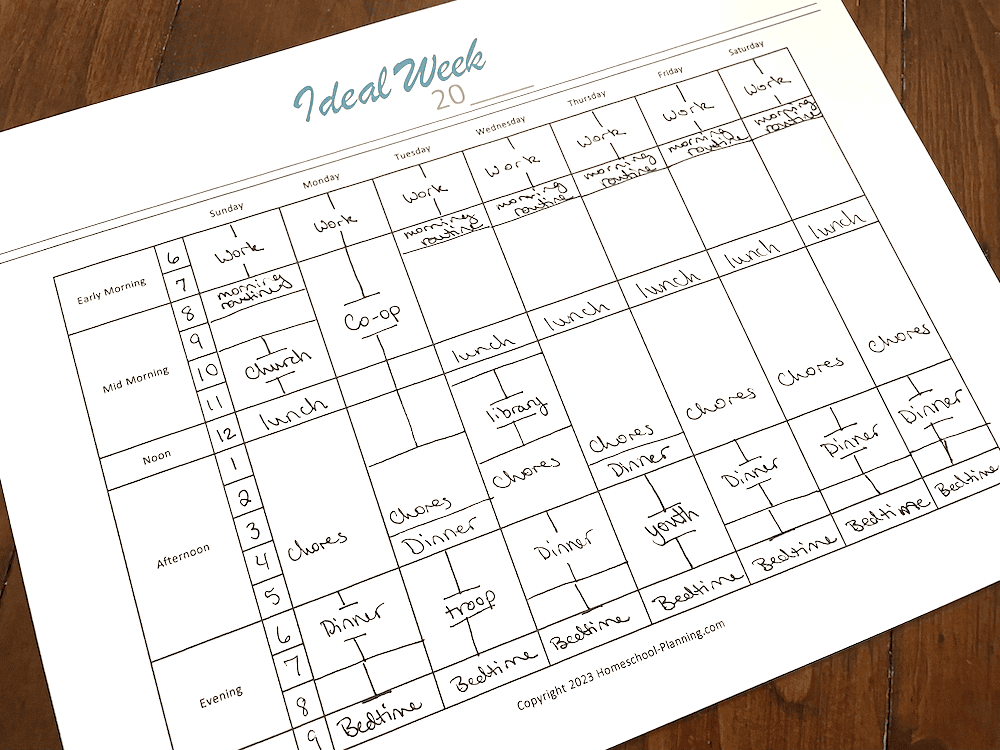
3. Input daily duties
After adding outside appointments to your weekly schedule, you will want to include standard daily duties within your home. These items often have some flexibility on times if needed, but are regular items that are included in your everyday lives. These will include things like:
- Wake up times
- Meals
- Chores and cleaning
- Cooking
- Getting dressed
- Nighttime routines
- Exercise
- Nap times
- Bed times
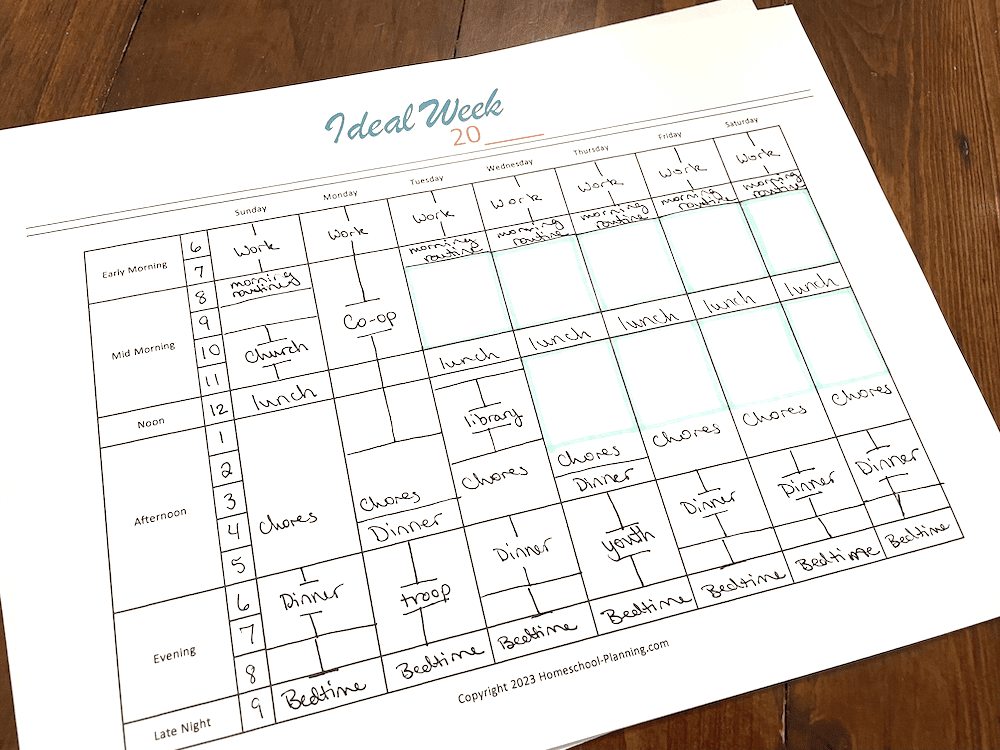
4. Choose your homeschool time
When homeschooling, it’s best to choose your homeschool time in your day, then work other things around it. Of course, this will not be possible for all families. But when possible, making homeschooling your first priority will help you be more consistent with it.
Since your immovable items have already been entered into your weekly schedule, you should be able to easily see large chunks of time you could use for homeschooling. Mark the chunks of time you will set aside for that. You can decide later how you use that block of time, but for now, it’s just the framework.
Read: Design your perfect daily homeschool routine in 10 easy steps
You might get to this point and see that your week is already too full to add a homeschool time. So what do you do? Well, you can move things around if possible.
But if you truly aren’t finding time, maybe it’s time to let some things go. House cleaning can suffer. Make some more simple meals. Drop a few extra-curricular activities.
If you are wanting to homeschool, it MUST be a priority.
Also, don’t look at it purely from a perspective of a typcial public school schedule. You can also look at the weekends or the evenings. THis is why we look for the empty times in your week.
How long?
Depending upon factors like the ages of your kids and the curriculum you use, formal homeschool learning will take somewhere between 1-5 hours each day. Of course, learning does not only happen while sitting at a desk, so be sure to figure in informal learning and play as well.
Here is a chart with general guidelines for formal learning for each age range:
- Preschool/kindergarten: 30 minutes-1 hour
- Elementary: 1-2 hours
- Middle School: 2-3 hours
- High School: 4-5 hours
Note that these times are only guidelines for formal learning only, and other learning should be encouraged outside of these ranges. Through play, books, experiential learning, etc.
Read: Homeschool attendance records – the ultimate guide
For instance, some states require 4 hours a day for any age. But this doesn’t have to mean sitting at a desk the whole time. Consider that this time for a young child will likely be more play time and less bookwork. While older children it will be the reverse.
Homeschoolers have the ability to schedule their time in the way that works for them. If this means it is in the evening, then do that. Many will do school in the mornings, but if it is better for you in small 30-minute chunks throughout your day, then great! You don’t have to do school from 8-3 every day.
Which days?
You also may want to consider which days in your week you plan to do school. Weekends may work well for you while Mondays are terrible. Or you might prefer to do school only 4 days a week, or even 6.
Planning which days you do school each week may be heavily influenced by your annual homeschool calendar. If you have not already planned your annual homeschool schedule, then work through the steps in my post about planning your year with attendance planning sheets.
Remember this is just a framework, and as you get further into planning your daily schedule, you may decide to re-work your weekly homeschool schedule. Just get yourself a starting point to work from for now.

5. Find time for other tasks
Now that the big things in your weekly schedule are filled in, you can begin to fill in a few of the other things in your life. These things will be the more flexible and movable items in your week. They are things that get done regularly but are not as affected by the time they are completed.
Some of these things could be figured into your daily routines or into homeschool time, but some find it helpful to mark them separately.
You may want to allow a whole day each week for errands, cleaning the house, and doctor appointments so you can stay on top of things without sacrificing your school schedule. Or you may be like me and find it helpful to leave certain hours available each day for these things. For us, it’s a couple hours most afternoons.
This will be things like:
- Running errands
- Grocery shopping
- Weekly chores
- Music/sports practice
- Therapy stretches and practice
- Exercise
- Household finances
- Scheduling appointments
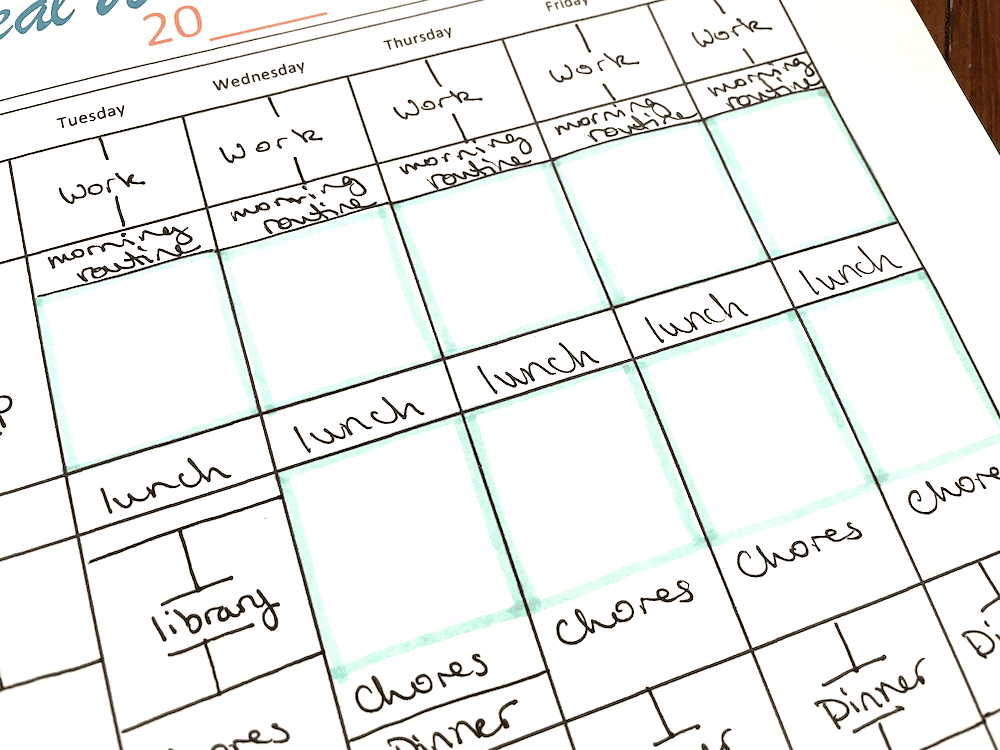
6. Leave margin
Nothing ever seems to go as planned when it comes to kids, so it’s important to leave margin in your weekly homeschool schedule to allow for overflow and the unexpected. This is time that is not allotted on your schedule. Like the blank space (margin) on a piece of notebook paper.
Some suggest only scheduling about 75% of your time, knowing that you will often need that extra time for other things. This will allow for changing between tasks, interruptions, someone crying, a spill, bathroom breaks, a phone call, or any other number of things that happen in your day.
This is like scheduling 4 hours for 3 hours worth of things. Or one hour for something you expect to take 45 minutes.
Keeping margin in your day will help with stress and the feeling of being behind.
Read: How to have a flexible homeschool schedule
One way to keep margin in your schedule is to have a flex time in your day. Afternoons at our house are a flex time. It is marked as free time, but can easily contain overflow from school work.
It is also time I can use for errands or household projects. Sometimes my kids have free time while I work and sometimes we work together. But if nothing else is needed, it is free time for us all.

7. Think about field trips and outings
Field trips and outings can take up a large amount of our time as homeschoolers. When you are focused on getting formal learning accomplished, it can be easy to overlook the fun. If this is you, then you may find it helpful to have a plan to allow for these extra things in your week as you decide to do them.
Some may decide to do outings as they come up in their year on any day, just dropping their normal schedule. Others may prefer to keep a set day for field trips so they can make sure they happen regularly and don’t miss their regular homeschool work. Either way works, but finding the way that works for you will help make sure it all gets done.
You may find you like to do regular school work 4 days a week, leaving one day for field trips. On weeks you don’t have something planned, you could do household projects, another day of regular school work, or just take the day off!

8. Evaluate and adjust
Now is the time to evaluate your week and adjust as needed. Are you doing too much? Is there not enough? Have you overscheduled and are finding it hard to fit homeschooling into the mix? Now is a good time to back off and evaluate your priorities for your homeschool.
It’s often helpful to view your whole week on one sheet so you can get a feel for what you truly have to do. Sometimes you will get everything plugged in and it will seem sparse, while other times you know it is too much. Finding the balance that works for you will be vital to your weekly homeschool schedule being a success.
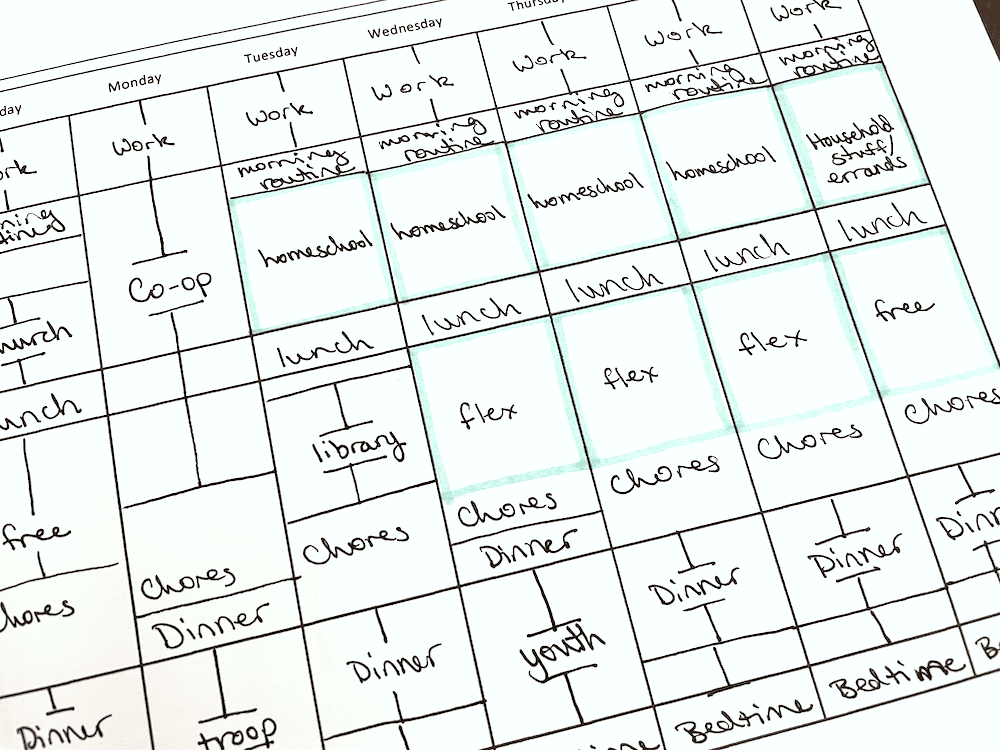
9. Keep it flexible
When you view your week as a framework you can adjust rather than a box that holds you in, you are able to keep your schedule flexible. I like to think of my schedule like the walls of a Lego house. I am a Master Builder and can easily move everything around to build the best home(school) for my family.
Over the years, we will adjust the walls of our schedule, making them taller and shorter. Some years might be an open floor plan while others will need small rooms to move within. Our time is sometimes more limited.
We may enjoy many hours of freedom on the porch when the kids are young. As the kids get older, we may need to add on to the house and build in some more formal learning hours.
When the house is fairly stable, I bring in the furniture and decor that is our curriculum and it can be comfortable to stay a while.
One thing I never forget is that I am the Master Builder. This is my creation. Those walls are easy to move, and the furniture can be sold off. Some of your walls can be curtains for a while so it’s easy to pass through or just pull to the side and leave open. There is no scheduled boundary that can’t be moved.
Your time, your attentions, and your curriculum, are all in your hands to be adjusted as you need. Build your dream creation and enjoy it. But don’t be afraid to move things around.
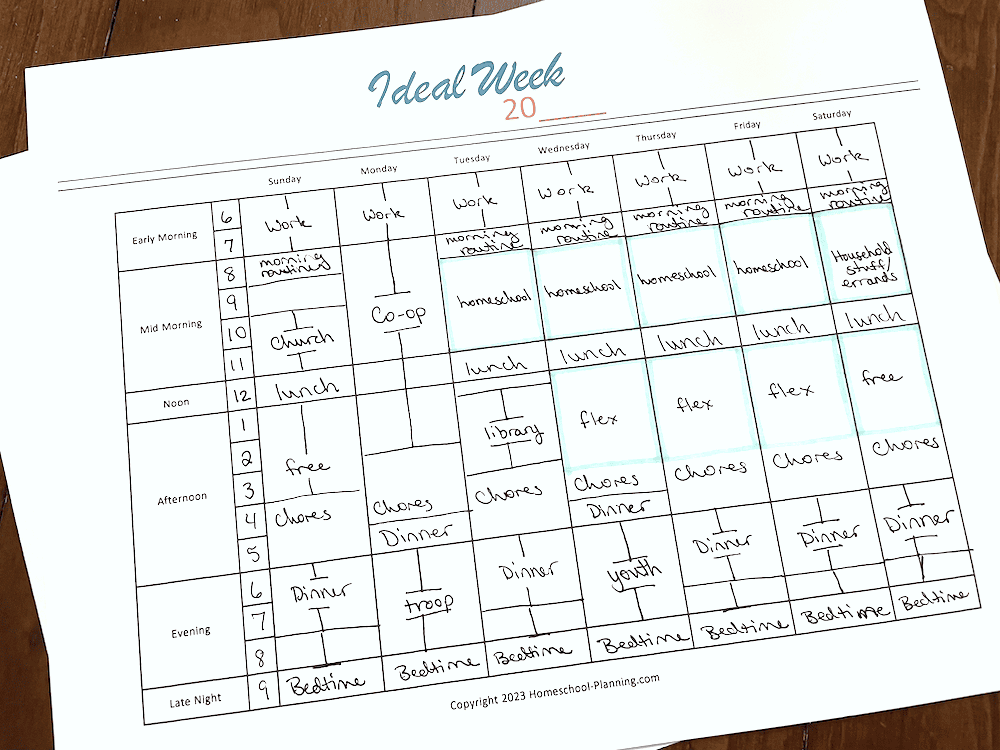
10. Use this as a basis for a daily homeschool schedule
You should now have your general overview laid out and able to view. Now with that general framework in place, you should be able to easily go more in-depth into your daily schedule.
To continue on your scheduling journey, check out my tips for creating your daily homeschool schedule in this post.

Sample weekly homeschool schedules
Over the years, I have created many homeschooling weekly schedules for my family. I have included a few below. You’ll notice some are basic, some are more full, depending on the season of life. Every part of life has different needs, and your schedule will reflect those needs.
Weekly homeschool schedule printable
Creating your personalized weekly homeschool schedule is easy with these FREE worksheets!
Create a flow for your day and week, making the necessary time for what is important: homeschooling your children.
Yes, these are the same worksheets you’ve seen in pictures throughout this post. Take a huge step toward getting your homeschool days running smoothly and download your free worksheeets today!
Weekly homeschool schedule
Creating a weekly homeschool schedule is simple and straightforward. First, add tasks that are fixed to certain times to help lay the groundwork. Then block out your homeschool time next to keep it a priority. Finally, you can easily fill in other tasks, outings, and fun within what is left. Setting this framework will help you lay the foundation for a great homeschool schedule!
Related Posts
Creating a daily homeschool schedule that works












